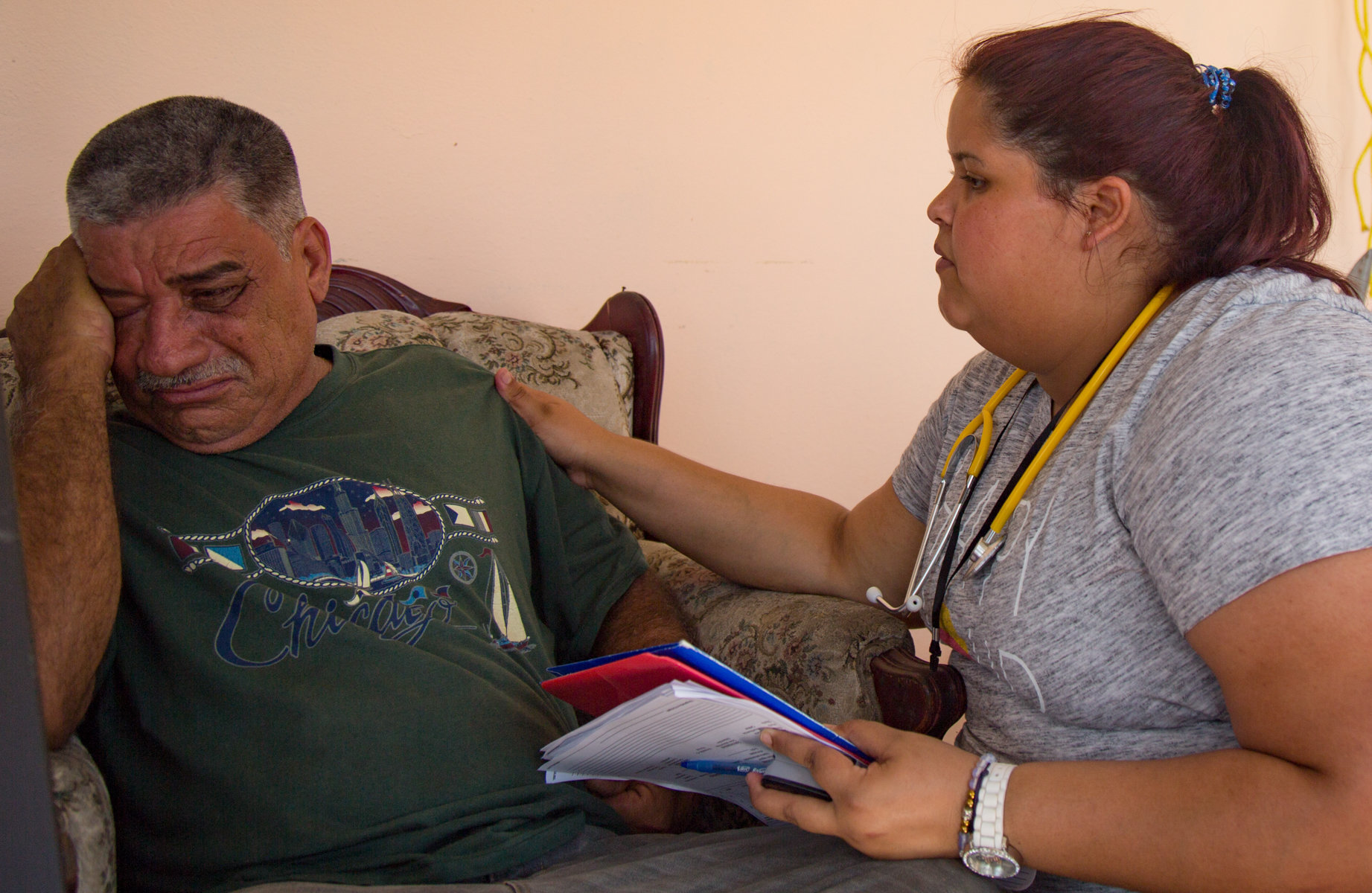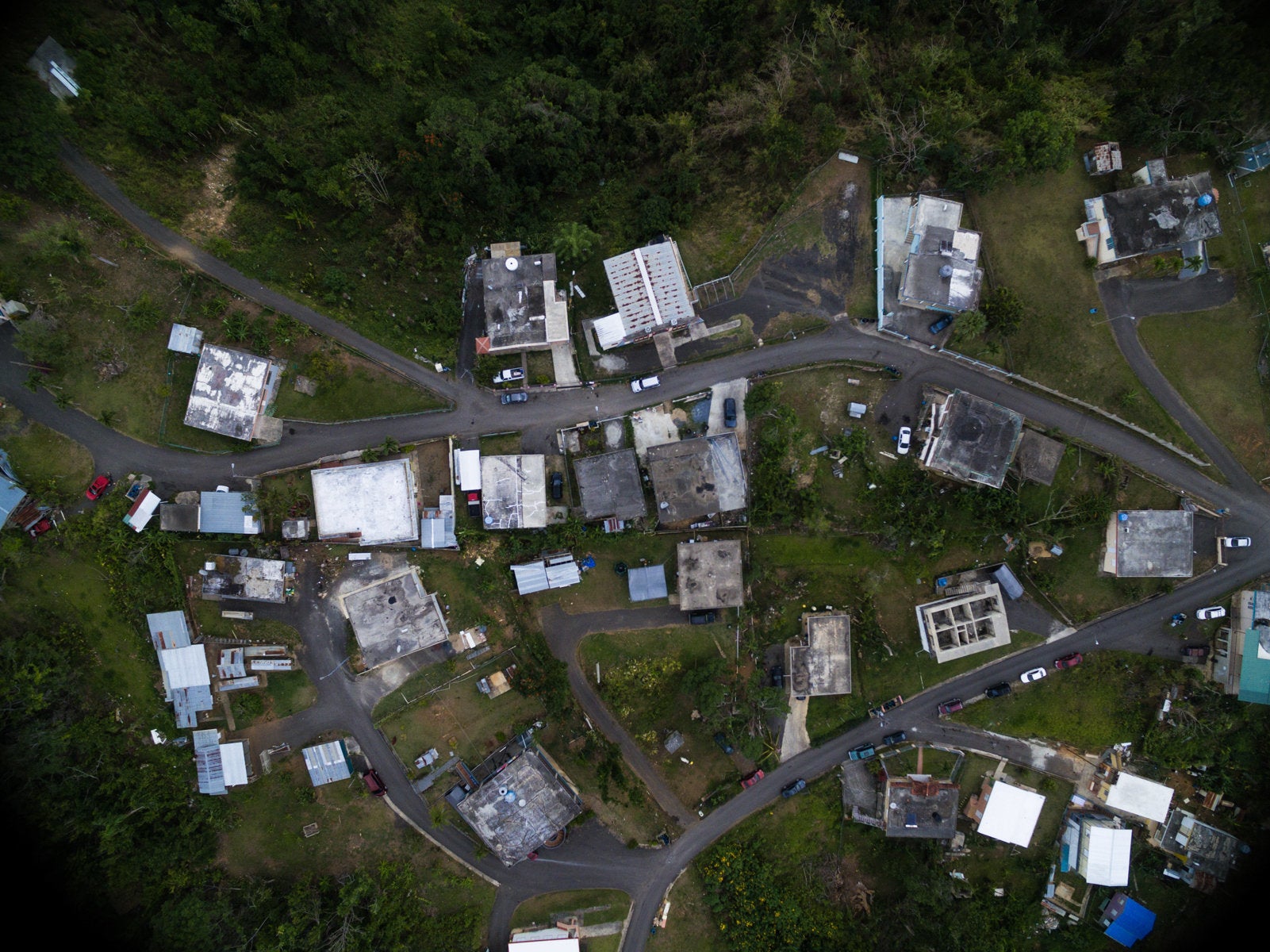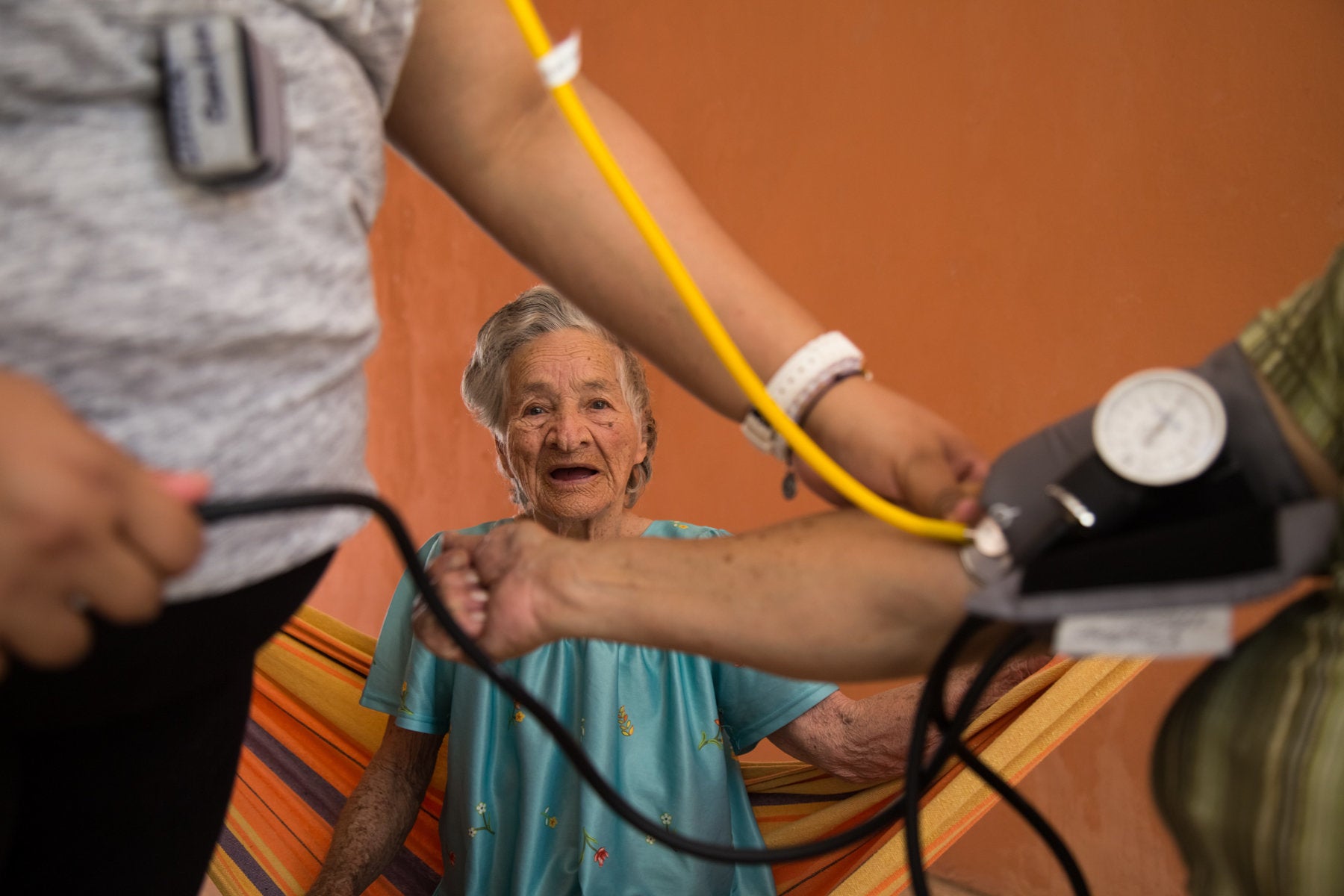
Publicado el 13 de agosto de 2018
Por Danielle Chemtob
With their community in crisis, Puerto Ricans are stepping up to care for those who have been forgotten. One organization is turning desperation into hope.
For more than six months after the storms, Ingrid Morales settled down to sleep every night on a thin canvas cot, surrounded by water bottles, medications and other supplies soon to be on their way to the survivors of Hurricane Maria. Her 7-year-old daughter slept on a cot next to her, and her husband slept in an adjacent room also stacked with boxes of supplies.
The family wasn’t sleeping at the makeshift clinic because they were displaced, like so many Puerto Ricans after hurricanes Irma and Maria battered the island. The family lives nearby, and while they lost some clothes, appliances and mattresses, the home itself was unscathed.
But Morales is responsible for handling the donations that Clínica Bantiox ― a health clinic set up in a preschool just six days after Hurricane Maria ― receives from organizations around the world. She stays there to ensure that everything, from the blood sugar meters to diapers, stays safe overnight.
At one point, more than 100 doctors, nurses and other volunteers slept alongside the Morales family at the clinic. By March 2018, it was just the Morales family. As a member of the administrative staff, Morales felt the responsibility was too important to abandon, which is why she spent so many nights there. But she also has a personal reason to stay.
“I think that giving is healing,” she said.
The clinic is just one component of Iniciativa Comunitaria, a nonprofit that is helping address health care needs after the storm. It also runs brigades that bring mobile clinics to communities around the island. The Puerto Rico-based organization has been around for over 25 years, sending groups of volunteers they call brigades to respond to crises in Haiti, Guatemala and elsewhere across the world.
Now, the volunteers’ homeland is in crisis. The water levels in Toa Baja, the low-lying suburb of San Juan where the clinic is located, reached nearly 20 feet during the storm, leaving some residents stranded on their roofs. In the aftermath, Iniciativa Comunitaria has helped more than 6,000 people between its clinic and its brigades.
The members of the brigade started their journey more than nine months ago. It’s their longest mission ever.
Continual Healing
While Hurricane Maria no longer makes headlines every day on the United States’ mainland, Puerto Ricans are still recovering physically and emotionally from the island’s most devastating storm in decades. Doctors and medical professionals are needed more than ever.
Even before the storm, Puerto Rico’s financial crisis had driven doctors away from the island in search of jobs elsewhere. Between 2006 and 2016, 5,000 doctors emigrated away. Furthering the medical crisis, an estimated 10 doctors per day have left the island since the storm, according to local news outlet El Nuevo Día.
“Everything was so disrupted that their income stopped, their offices were destroyed,” said Dr. Wendy Matos, executive director of the University of Puerto Rico’s faculty practice plan. “It’s like the rug was taken out from under their feet. People made decisions to survive.”
Those who remain are picking up the pieces.

An overhead view of one of the communities Iniciativas De Paz serves reveals that some houses are entirely without roofs, and others are still making do with the tarp roofs installed by FEMA. Alexis Fairbank
“You have to do it because if not you, then who is going to do it?”
As the sun rose in Toa Baja on a Wednesday morning in March, the clinic brimmed with volunteers preparing to set off on the mission.
They packed duffle bags full of medications and supplies, including blood sugar monitors, vaccines and antibiotics. Franchely Soto, Iniciativa Comunitaria’s logistics coordinator, darted around volunteers with a clipboard, checking off her list with precision.
Things weren’t always so organized. To set up a clinic in six days, they had to make do with the facilities and limited supplies they had at the time. The clinic inhabits one of the rooms in the preschool, and several other classrooms ― including the one where Morales sleeps ― hold supplies.
Stethoscopes hang on plastic hooks, Post-its and papers plaster the walls and the staff sits at card tables. A curtain divides the waiting area and administrative offices from where patients are seen.
In front of the door, a sign greets patients: “We are a big hug.”
You have to do it because if not you, then who is going to do it?José Luis Vargas Tapia
The brigade has been on nearly 70 missions, and they have the process down like clockwork.
Vargas Vidot, who is now a senator in the Puerto Rican legislature, started Iniciativa Comunitaria to address HIV among drug users and the homeless. The program has grown to offer 12 different services.
Around a year after he was elected in November 2016, his son, José Luis Vargas Tapia, took over leading Iniciativa Comunitaria’s brigades.
For their morning briefing, Vargas Tapia gathers around 20 volunteers: doctors, medical students, nurses, administrators and anyone else who happens to be on hand that day.
The community they’re about to serve ― Aguada, a small town on the island’s west coast ― is more than 80 miles away, but Vargas Tapia talks about patients whom he’s never met like they’re family. Some still don’t have power or water. Fallen trees still line many roads.
“Here we have no titles; here we are human beings serving other humans,” Vargas Tapia told the volunteers. “That’s it.”
The volunteers load into a caravan of cars and set off through the countryside, watching as the buildings of San Juan give way to lush rolling hills, where Aguada overlooks a valley and a glimmer of the coastline.

Abdona Villonueva suffers from dementia and Alzheimer’s but still happily spends her time swinging on her hammock in her home in Aguada. She is cared for by her daughter Carmen who is having her blood pressure checked while Abdona watches.
After unpacking their supplies in the hot sun, Vargas Tapia and his team split up to visit patients, some of whom are bedridden. They have 37 people on their list.
One of them is Isidra Perez. Iniciativa Comunitaria’s van pulls up to her house, and a doctor and nursing student hop out.
Perez, who is bedridden, has suffered from multiple ailments, including severe bronchitis and ulcers. A lack of electricity can be life-threatening for the elderly population, so after losing power in the storm, Perez’s family used their generator between five and seven hours per day for five months to run the air conditioning.
They only ran the generator in bursts, but the cost of the gasoline to fuel it added up quickly. The family struggled to afford the nearly $1,000 cost.
Perez needed to be taken to the hospital not long after the storm hit, but because the roads were blocked with debris there was no way to get to the hospital. Her family struggled to keep her healthy in the long weeks with no power or access to medical care. Luz Bonilla, Perez’s daughter, was finally able to heal her mother using natural remedies.
“At the beginning you feel desperate: no water, no light, no this, no that,” said Bonilla. “But little by little you say, ‘Hello, this is something I can overcome,’ and little by little we settled.”
Because Bonilla works at a local hospital, she was able to get in touch with her doctor and take care of her mother, but others still struggle to access medical care.
Although hospitals are now open, they face supply and staff shortages, and in the storm’s wake some did not accept patients from other areas. Some patients have had to wait nearly a full day to receive treatment.
But it’s patients with long-term diseases like diabetes who are most at risk.
According to the Centers for Disease Control and Prevention, nearly 16 percent of Puerto Ricans reported having diabetes in 2014, compared to 10.1 percent for the U.S. population as a whole. A study from the University of Puerto Rico’s Medical School found that nearly 40 percent of adults in San Juan suffered from hypertension.
And a loss of power for some diabetics can be a life or death situation, as insulin needs to be refrigerated.
“The deaths after a disaster come from untreated chronic illnesses,” Vargas Vidot said. “So diabetes is endemic here. Hypertension is endemic. Cardiovascular problems are endemic.”
Chronic illness fatalities aren’t reflected in the storm’s official death toll of 64, even if many wouldn’t have happened otherwise. A study from researchers at Harvard estimated the death toll could be more than 4,600.
Matos of the University of Puerto Rico says that the storm can also exacerbate other long-term health consequences that often get overlooked, such as mental health issues and suicide risk.
The number of deaths by suicide had already increased in Puerto Rico by 29 percent between 2016 and 2017, after years of decline. And a 2012 study of inner city primary care patients in Puerto Rico found that 14 percent had probable post-traumatic stress disorder.
While it’s too early for most research to track the long-term impacts Hurricane Maria could have had on PTSD, for instance, research on 2005’s Hurricane Katrina can provide clues. A study of low-income parents in the 18 months following Hurricane Katrina found that nearly half exhibited signs of probable PTSD.
“The government disregarded the effect of a disaster on the emotional state of people,” Matos said. “That affects directly not only the thinking process and decision making, but their physical conditions too.”
During their brigades, the volunteers keep that concept in mind, focusing on both emotional and physical health. One volunteer plays guitar for the patients. It’s a remedy for the loneliness the increasing number of elderly people face.
Between 2014 and 2016, the share of the population older than 65 increased from 14.5 percent to nearly 19 percent, while the share of people under 18 declined, according to U.S. Census Bureau estimates.
The government disregarded the effect of a disaster on the emotional state of people. That affects directly not only the thinking process and decision making, but their physical conditions too.Dr. Wendy Matos
Since the storm, experts say the exodus of young people has only gotten worse. As of January, more than 200,000 Puerto Ricans had fled the island for the mainland. Most of them are the island’s youth.
“The young people are the future, and if they are leaving, what’s gonna happen?” said Carla Santiago, a third-year medical student at the University of Medicine and Health Sciences on Saint Kitts island, who doubles as a volunteer with the brigade. “Puerto Rico needs more young people to rebuild.”
Sometimes, the elderly just need someone to talk to, or share a song with. And that’s where Iniciativa Comunitaria comes in.
The People Left Behind
As Inciativa Comunitaria’s daytime volunteers pack up and head back to Toa Baja, the night brigades are just getting started.
The group of undergraduate and medical students at the University of Puerto Rico is part of Recinto Pa’ la Calle, a program associated with Iniciativa Comunitaria that provides services at night for people who are homeless and drug users.
After loading cars with supplies, the volunteers pulled their vehicles up to an empty bus station, where just one other car was parked. Adriana Rodriguez, a third-year medical student at the University of Puerto Rico, hopped out of her car and approached a homeless camp, scattered with tents, mattresses and bicycles.
The camp’s residents brightened as she shouted, “Hola, Iniciativa!” from her car. After exchanging a few words with them, Rodriguez waved to her peers, who emerged from a caravan of cars donning Iniciativa Comunitaria’s logo.
The students handed out orange juice, coffee, sandwiches, clothes, toothpaste and condoms; anything they had in their supply of donations, they provided. Several of the students dressed wounds, while others just took time to listen to the stories of people in the camps.
René, who asked that his last name not be used, is the leader of this homeless camp. The other residents call him “the Veteran.” The members of the camp survived the storm thanks in part to Iniciativa Comunitaria’s volunteers, who brought them and others to a temporary shelter at the group’s headquarters.
Most patients we have been seeing, they haven’t been seen by any physician or any group.Franchely Soto
Volunteers dropped off René and the others at the camp two days later. The storm destroyed what few things they had. Some of their mattresses were strewn against the fence along the other side of the wide lot. The bus terminal they rely on for light was without power. But still, René stayed.
“I would be leaving all my people behind,” he said. “People need me to be here.”
During the storm, many of Puerto Rico’s homeless population stayed on the streets. It’s the homeless, the elderly, drug users and other “forgotten” populations that Iniciativa Comunitaria focuses much of its efforts on. And many of those residents and volunteers alike say government assistance is not reaching those who need it most.
“Most patients we have been seeing, they haven’t been seen by any physician or any group,” Soto said.
Many of those communities are used to helping themselves. Cantera, an impoverished community in San Juan the brigade recently visited, has operated as a nonprofit for years, as have several others. The nonprofit leaders helped coordinate Iniciativa Comunitaria’s visit and identify patients.
“There’s a concept of community that doesn’t represent a geographic thing,” Vargas Vidot said.
That’s what drives Iniciativa Comunitaria’s volunteers to rebuild their community ― whether it’s a town on the opposite coast of the island, a poor neighborhood in San Juan or a bus station just outside of the University of Puerto Rico’s medical school where the homeless sleep.
“We saw Puerto Rico literally broken,” said Sofia Muns, a first-year medical student at the University of Puerto Rico. “If you see something broken, it’s human that you want to bring it back together.”
Photos and video by Hanna Davison, Alex Kormann, Alexis Fairbanks, Kaitlin Harlow and MaryRachel Bulkeley. Graphics by MaryRachel Bulkeley. With contributions from University of Puerto Rico students Roberto Santana and Shirley Colón.


